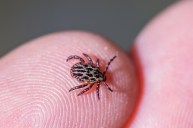You may have heard there's a condition that you can develop from a tick bite that leaves some people allergic to red meat. It's called alpha-gal syndrome—and two new studies out of the Centers for Disease Control and Prevention (CDC) say the condition may actually be more prevalent than they previously thought.
For hunters, this is a twofold disaster: It not only takes meat (including wild game meat like elk, venison, or moose) off the menu, but also, the likely scenario is that an infected tick was picked up while doing that thing the thing you love the most—hunting.
Two studies recently released by the Centers for Disease Control and Prevention (CDC) are giving scientists a better understanding of the fast-growing tick-borne problem that is estimated to affect up to 450,000 Americans.
How You Become Allergic to Red Meat
In the first of two studies by the CDC on the topic, alpha-gal syndrome is described as an emerging, tick bite-associated allergic condition. Basically, there's a certain sugar in a tick—alactose-alpha-1,3-galactose, or alpha-gal—that can be transmitted to a person. "We think that [ticks] have an enzyme in their saliva that can produce alpha-gal," Dr. Scott Commins, associate chief for allergy and immunology at the University of North Carolina School of Medicine and co-author on the new studies, said.
This is the same sugar as what's found in red meat and dairy products. Not everyone has a reaction to this transmission by a tick, but for some, their body reacts poorly, developing alpha-gel syndrome (AGS). The majority of people affected by alpha-gal will have minor symptoms such as hives, itching, and runny nose after eating meat or dairy. In rare cases, though, the condition can trigger anaphylaxis, a potentially life-threatening condition when the body overreacts to an allergen.
The Growing Numbers
And cases are on the rise: In one of the CDC studies, researchers looked at lab results across the country and found that the number of suspected cases in the United States has increased substantially since 2010.
The study also showed states with a lot of lone star ticks are the most affected, such the South and Midwest (although suspected cases were also identified in areas outside of this tick's range). In particular, the researchers point to Arkansas; Kentucky; Missouri; and Suffolk County, New York where the lone star tick is known to be established.
Researchers identified approximately 110,000 suspected cases since 2010, but estimate that the true number of alpha-gal cases in that span is more accurately around 450,000, due to a significant knowledge gap.
Which brings us to the second study, which found most scientists and health care providers don't know about the syndrome.
The second study surveyed 1,500 doctors and nurse practitioners throughout the US, and found health care providers have a low level of knowledge of alpha-gal syndrome. Of those surveyed, 78% of providers having little to no knowledge of AGS, 42% had never heard of the allergy, another 35% reported they were not confident about their ability to diagnose or manage a patient with alpha-gal allergy.
"The lack of health care provider knowledge of AGS is likely to lead to undertesting, further hampering knowledge of the national prevalence of AGS," the study read. "Increased education and awareness of AGS needed to hasten and improve the accuracy of AGS diagnoses, patient care, and the understanding of the epidemiology of this emerging condition."
READ MORE: 8 Famous Tick Myths That Are Nothing But Urban Legend




